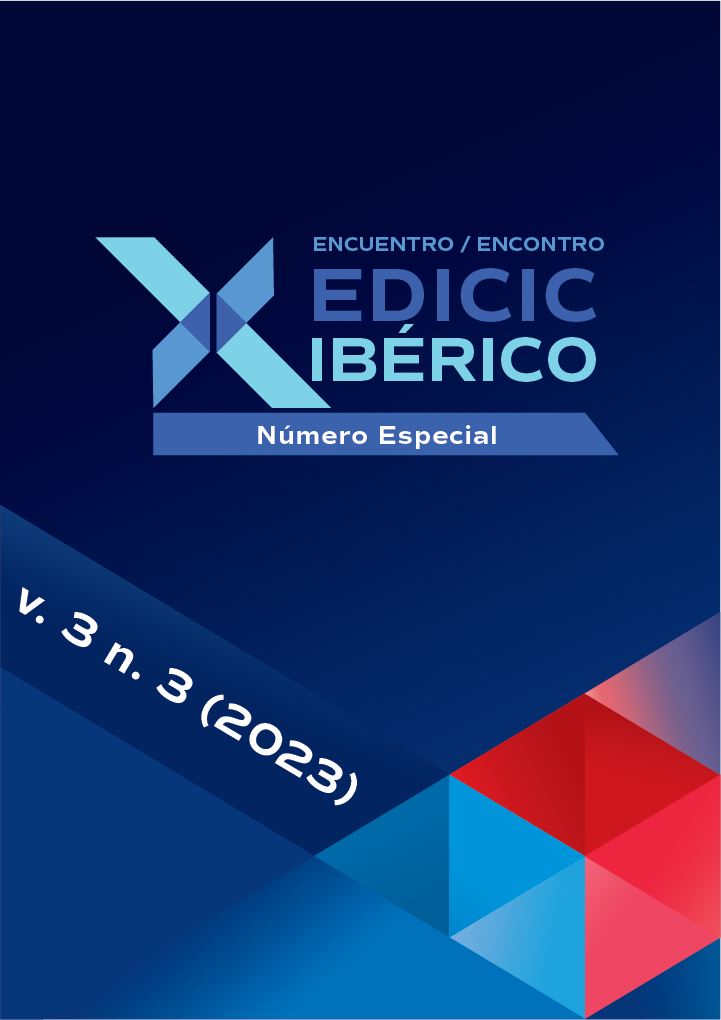Información y georreferenciación: una mirada a los sistemas de información geográfica en el ámbito de las ciencias de la información
DOI:
https://doi.org/10.62758/re.v3i3.201Palabras clave:
Sistemas de Información Geográfica, Ciencia de la Información Geográfica, Ciencia de la Información, Espacio Urbano, Humanidades DigitalesResumen
Appearing after the Second World War, geographic information systems surpassed the primary context of digital mapping to influence the configuration of urban space, directly interfering in the way societies have moved and related to equipment, platforms, and people, from the geolocation facilities in the hand palm. In this context, Geographic Information Science emerges as a theme that aims to bring studies carried out within the scope of geographic information systems to the behavioral implications of its users. This paper aims to identify the incidence of studies that address the topic of geographic information systems, based on scientific production in the Information Science field. In the methodological scope, it is configured as research of qualitative and quantitative nature, exploratory type and, for that, a bibliographic review was carried out in three international databases: Web of Science; Library, Information Science and Technology; and Information Science & Technology Abstracts, spanning the 20-year period (1999-2019). We sought to highlight the field of so-called Geographic Information Science as an integral part of Information
Surgidos después de la Segunda Guerra Mundial, los sistemas de información geográfica rebasaron el contexto primario de la cartografía digital para influir en la configuración del espacio urbano, interfiriendo directamente en la forma en que las sociedades se han movido y se relacionan con equipos, plataformas y personas, desde las instalaciones de geolocalización en la palma de la mano. En este contexto, la Ciencia de la Información Geográfica surge como un tema que pretende acercar los estudios realizados en el ámbito de los sistemas de información geográfica a las implicaciones comportamentales de sus usuarios. Este trabajo tiene como objetivo identificar la incidencia de los estudios que abordan el tema de los sistemas de información geográfica, a partir de la producción científica en el campo de las Ciencias de la Información. En el ámbito metodológico, se configura como una investigación de carácter cualitativo y cuantitativo, de tipo exploratorio y, para eso, se realizó una revisión bibliográfica en tres bases de datos internacionales: Web of Science; Library, Information Science and Technology; e Information Science & Technology Abstracts, que abarcan un período de 20 años (1999-2019). Buscamos resaltar el campo de las llamadas Ciencias de la Información Geográfica como parte integral de los estudios de las Ciencias de la Información. Los resultados demuestran una escasa producción sobre el tema en el campo de las Ciencias de la Información, en comparación con otras áreas del conocimiento, a pesar de un crecimiento considerable en la curva de citas de esa producción. Desde esta perspectiva, existen desafíos y perspectivas sobre los estudios centrados en los sistemas de información geográfica como objeto de investigación en Ciencias de la Información.
Citas
Araújo, C. A. Á. (2018). Um mapa da Ciência da Informação: história, subáreas e paradigmas. ConCI: Conv. Ciênc. Inform., São Cristovão (SE), 1(1), 47-72, jan./abr. DOI: 10.33467/conci.v1i1.9341 DOI: https://doi.org/10.33467/conci.v1i1.9341
Borko, H. (1968). Information Science: What is it? American Documentation, 19(1), 3-5, Jan. Recuperado de http://aprender.unb.br/course/view.php?id=3530. DOI: https://doi.org/10.1002/asi.5090190103
Bruno, F. (2013). Máquinas de ver, modos de ser: vigilância, tecnologia e subjetividade. Porto Alegre: Meridional.
Caeiro, S. (2013). Sistemas de informação geográfica: principais conceitos. Recuperado de http://hdl.handle.net/10400.2/2816.
Casalegno, F. (2006). Memória cotidiana: Comunidades e comunicação na era das redes. Porto Alegre: Sulinas.
Câmara, G.; Davis Jr., C. A. (2014). Introdução. In: Câmara, G.; Davis Jr., Clodoveu, A.; Monteiro, A. M. V. (Ed.) Introdução a ciência da geoinformação. São José dos Campos: INPE. cap 1. Recuperado de <http://www.dpi.inpe.br/gilberto/livro/introd/cap1-introducao.pdf.
Chapman, A. D.(2015). Princípios de qualidade de dados. Versão 1.0. Brasília: GBIF/SIBBR. Recuperado de https://books.google.pt/books?id=wp9ICAAAQBAJ&printsec=copyright&hl=da&redir_esc=y#v=onepage&q&f=false.
Duckham, M., Goodchild, M. F. & Worboys, M. F. (2003). Foundations of Geographic Information Science. London, England: Taylor & Francis. DOI: https://doi.org/10.1201/9780203009543
Goodchild, M. J. (1992). Geographical Information Science. International Journal of Geographical Information Systems. 6(1): 31-45. DOI: https://doi.org/10.1080/02693799208901893
Kirsh, A. (2014). Technology is taking over English departments. The false promise of the digital humanities. The New Republic. Recuperado de https://newrepublic.com/article/117428/limits-digital-humanities-adam-kirsch.
Leite, J. (2008). A ubiquidade da informação digital no espaço urbano. Logos, 15(2), 104-116. DOI: https://doi.org/10.12957/logos.
Lemos, A. (2008) Mídias locativas e territórios informacionais. In: Santaella, L. & Arantes, P. (Eds.). Estéticas tecnológicas: novos modos de sentir. São Paulo: EDUC.
Longley, P. A., Goodchild, M. F., Maguire, D. & Rhind, D. W. (2005). Geographic Information Systems and Science (2.ed.) Chichester: Wiley.
Mark, D. M. (2000). Geographic information science: Critical issues in an emerging cross-disciplinary research domain. Journal of the Urban and Regional Information Systems Association, 12(1): 45-54.
Mark, D. M. (2003). Geographic Information Science: Defining the field. In: Duckham, M., Goodchild, M. F. & Worboys, M. F. (2003). Foundations of Geographic Information Science. London, England: Taylor & Francis.
Melo, D. H. C. T. B., Silva, H. M., Brito, P. L. & Menezes, L. A. (2015) Sistema de informação geográfica: uma análise sobre o desenvolvimento técnico, tecnológico, acadêmico e conceitual. Revista MundoGEO, Curitiba, 17(83), Sept. Recuperado de http://mundogeo.com/blog/2015/09/10/sistema-de-informacao-geografica-uma-analise-sobre-o-desenvolvimento-tecnico-tecnologico-academico-e-conceitual/.
Pickles, J. (1997) Tool of Science? GIS, Technoscience, and Theoretical turn. Annals of the Association of American Geographers, Washington, 87 (2), 363-372, jun. DOI: https://doi.org/10.1111/0004-5608.00058
Policarpo, C. & Araújo, R. F. de (2019). Jogos locativos, territórios informacionais e a cidade como interface: conectividade e vigilância na experiência Pokémon GO. Liinc em Revista, 15(1). Recuperado de https://doi.org/10.18617/liinc.v15i1.4612. DOI: https://doi.org/10.18617/liinc.v15i1.4612
Ribeiro, J. L. P. (2014). Revisão de investigação e evidência cientifica. Psicologia, Saúde & Doenças, 15(3), 671-682. Recuperado de https://dx.doi.org/10.15309/14psd150309. DOI: https://doi.org/10.15309/14psd150309
Santaella, L. (2007). Linguagens líquidas na era da mobilidade. São Paulo: Paulus.
Silva, H. B. G. e, Leite, H. O. & Pinheiro, M. M. K. (2016). A dualidade das cidades inteligentes: melhoria da qualidade de vida ou controle informacional? Informação & Sociedade: Estudos, 26(3). Recuperado de https://periodicos.ufpb.br/ojs2/index.php/ies/article/view/29309.
Sousa, M. C. P. (2015). as humanidades digitais globais? Anotações. Recuperado de https://humanidadesdigitais.org/hd2015/anotacoes/.
Thatcamp (2011) Manifesto das humanidades digitais. Paris: 2011. Recuperado de https://humanidadesdigitais.org/manifesto-das-humanidades-digitais/.
UCGIS (2002). UCGIS bylaws. Recuperado de http://www.ucgis.org/fByLaws.html.
Wersig, G. & Neveling, U. (1975) Os fenômenos de interesse para a Ciência da Informação. Recuperado de http://www.alvarestech.com/lillian/GestaoDaInformacao/Rogerio/WersigNeveling.pdf.
Wing, B. P. (2015) Text-based document geolocation and its application to the digital humanities. Tese (Doutorado) – University of Texas, Austin, 2015.
Descargas
Publicado
Cómo citar
Número
Sección
Licencia
Derechos de autor 2023 Revista EDICIC

Esta obra está bajo una licencia internacional Creative Commons Atribución 4.0.
La Asociación posee los derechos de autor de los textos que publica y adopta la licencia Creative Commons, CC BY 4.0 DEED Atribución 4.0 Internacional (https://creativecommons.org/
Usted es libre de:
- Compartir: copiar y redistribuir el material en cualquier medio o formato para cualquier propósito, incluso comercialmente.
- Adaptar: remezclar, transformar y construir a partir del material para cualquier propósito, incluso comercialmente.






